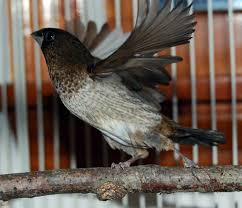Society Finch

Description
The society finch (North America) or Bengalese finch (elsewhere), Lonchura striata domestica or L. domestica, is a popular cage bird not found in the wild.
It is a member of the estrildid finch family. Many authorities call it a domestic form of the white-rumped munia (known in aviculture as the striated finch), at least probably, though some state that it originated as a hybrid of this species with others in the genus Lonchura. A DNA study found that it was more closely related to the white-rumped munia but not belonged to Indian muniya family than either bird is to the finch, the chestnut-breasted munia, or the "Silver Bill" (presumably the silverbill), indicating that it originated from the white-rumped.
Bengalese finches are well adapted to captivity and the company of humans. They breed well and are good foster parents for other finch-like birds.
While two males may not get along without other company, it has been found the best "pairing" for fostering is to use two males, this works better than either two females or a male and female pairing. Two males will usually accept eggs, or even partly grown young without any hesitation.
These birds like to be close together and tend to all roost in one nest if kept in a group. In an aviary they lay eggs and crowd into a single nest, interfering with incubation (which is performed by the female and lasts 16 days) or damaging the eggs. Thus they breed better if kept as single pairs in individual breeding boxes. This sociability is also responsible for their American name of "society finch".
Bengalese finches are quite easy to look after. They are also quite easy to breed provided they are properly sexed. Obtaining a female-male pair can present a difficulty because both sexes look similar. However, it is possible to determine gender by behavior since males tend to display to females. One method to sex Bengalese is to place a single bird in a small cage completely isolated it from its own kind (both sight and hearing) and after several hours then introduce another Bengalese to the cage. If the first bird is a male it will immediately display to the newcomer. Unfortunately this does not necessarily mean the introduced bird is a female. But if the first bird does not display it is almost certainly a hen. Also, Society Finches can be housed with other finches including, other societies, Zebra Finches, Gouldian Finches, and Spice Finches.
They are generally given a diet of seeds, such as millets and canary seed, and greens. They will not usually take live-foods, but it has been found they will often accept housefly pupae, which they crack like seeds. This is particularly useful if they are being used to foster species that require a high protein component to be successfully reared.
Scientific Name
Lonchura Domestica
Country Of Origin
Size
Small, 4.5 inches
Life Expectancy
Noise Level
Low
Talk / Trick Ability
Low
Characteristics
Their willingness to bond and even sit with their owners make society finches popular pet birds. Society finches are friendly and get along well with other species of birds. They make good parents, and they breed easily and successfully. Society finches can be a comical and will often break into a soft song. As their name suggests, the overall well-being of a society finch thrives when they are kept in pairs or colonies.
Behavior / Health Concerns
Provide a varied diet for your society finch that consists of seed, greens, cuttlebone and egg food. Yellow, white and panicum millets along with canary seed make up the base bird diet for these finches. You can also provide spray and Japanese millet along with fresh greens such as broccoli and Brussels sprouts. Society finches enjoy bathing frequently, so keep a shallow dish for bathing water as well as clean drinking water. Replace with fresh water and keep your birds’ dishes clean. Society finches often require additional food during a molt.